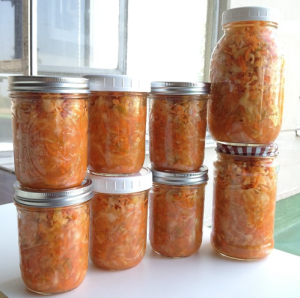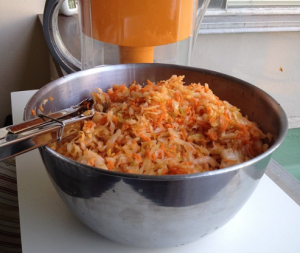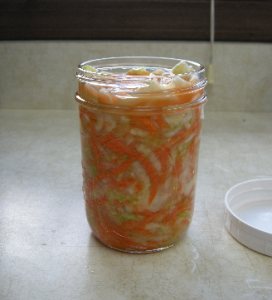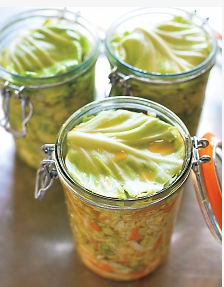CULTURED VEGGIE “PROBIOTIC” SALAD
Cultured veggies are one of the healthiest foods that you can give yourself on a regular basis. Most other cultures eat cultured veggies on a regular basis. I call this salad ‘cultured veggies,’ or ‘probiotic salad,’ or ‘sauerkraut.’ Now, stay with me! This is the next generation of sauerkraut!
It is tangy and delicious, and it supplies your body with ample, life giving probiotics, and digestive enzymes.
Preparation time: 10 minutes
“Culturing” time: 4 days to 3 weeks
*You’ll culture these for 7 days
Yields 2 quart sized jars
GREEN CABBAGE, CARROT, CELERY AND DILL CULTURED VEGGIE SALAD
2 quart sized, clean glass jar with rubber lid and screw top lid
2 pounds green cabbage
½ pound carrot
½ pound celery
2 sprigs dill, chopped
1 T sea salt (you may use less if you like)
Reserve one outer leaf. (You can use other veggies instead of cabbage if you have a “culture starter,” OR make sure at least 1/4 of the jar is cabbage… the cabbage contains the live cultures needed to start the fermentation process).
INSTRUCTIONS
1. Shred cabbage, carrots and celery as you like either with a knife, cabbage shredder, or food processor. Put into large mixing bowl.
2. Add salt and chopped dill and use your hands or some type of tampering device to pound and mix the cabbage well (so that you break open the cell walls and release some of the natural juices). You should give the cabbage a good 3 to 5 minutes of mixing and pounding.
3. Pack the cabbage down tight in a clean quart sized jar. The liquid should come up over the cabbage when pushed down. Leave only an inch space from the top. If you need to you can add some filtered water. You don’t want a lot of air at the top.
4. Use one of the outer cabbage leaves and tuck it in around the shredded cabbage to protect it from air. It is okay if some juices come up over the cabbage leaf. In fact, this is preferred.
5. Put the lid on, but do not screw tight. Place in a baking dish or on a plate to catch any juice that might push out over the first couple of days.
6. As it’s fermenting, keep the sauerkraut away from direct sunlight and at a cool room temperature — ideally 65°F to 75°F. Check it daily and press it down if the cabbage is floating above the liquid.
Because this is a small batch of sauerkraut, it will ferment more quickly than larger batches. Start tasting it after 3 days — when the sauerkraut tastes good to you, remove the weight, screw on the cap, and refrigerate.
7. You can store in refrigerator or if you plan to eat it over a couple of week’s you can just leave it out (sealed) at room temp.
Check on the Brine It is important that the cabbage stay submerged in liquid. If the brine bubbles out during fermentation, replace it with a solution of coarse salt dissolved in filtered water, using a ratio of one tablespoon to one cup.
While it’s fermenting, you may see bubbles coming through the cabbage, foam on the top, or white scum. These are all signs of a healthy, happy fermentation process. The scum can be skimmed off the top either during fermentation or before refrigerating. If you see any mold, skim it off immediately and make sure your cabbage is fully submerged; don’t eat moldy parts close to the surface, but the rest of the sauerkraut is fine.
There’s no hard and fast rule for when the sauerkraut is “done” — go by how it tastes.
Fermentation is idea at ideally 65°F to 75°F. In hot weather, let the jars stand in a dark corner in the back of a closet. At cool times of the year, a cupboard above the refrigerator is a safe bet.
Store sauerkraut for several months: This sauerkraut is a fermented product so it will keep for at least two months and often longer if kept refrigerated. As long as it still tastes and smells good to eat, it will be. If you like, you can transfer the sauerkraut to a smaller container for longer storage.
Get creative and try adding things like shredded onions, garlic, chili flakes, chopped greens, or even shredded green apples!




